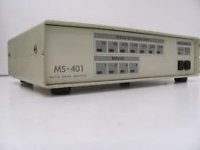Mike_Z
Veteran Member
This morning I picked up this RS-232 switch at a swap meet for $5. Don't know it if it works, if it doesn't it is a nice box for a future project. BUT, if it does I can switch between RS-232 devices with my 8080A computer. I didn't get any documentation with it, and I'm assuming it is a simple plug and play device. There is a common DB25 plug on the back that I assume would connect to the computer Rs-232 port. Then there are 4 other DB25 plugs where the devices would go. The front panel monitors the common port conditions CTS etal. There is a button that selects the port to use. Does anyone have any experience with one of these? Is it as simple as it seems. I have to find a 9 VAC power supply and give it a try. I've been looking for documentation on it, but I don't even know who made the unit. There is no tag on it.

Thanks Mike.

Thanks Mike.
